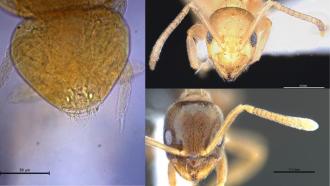![Indian queenless ant (Diacamma indicum) [Photo Credit: Kushankur Bhattacharya, Ant Lab, IISER Kolkata] For these ants, the road to their new nest is almost never long](/sites/researchmatters/files/styles/large_800w_scale/public/diacama_indica_3.jpg?itok=I9gzZtUz)
Study shows how a species of Indian ants choose the shortest path when they relocate their nest.
In the age of Google Maps, going from one place to another in the shortest time or distance is a cakewalk. The complex algorithms in the application do all the maths, taking into account the traffic, route restrictions and the distance, and pop up the best route. Insects, with their tiny brains, can also do such sophisticated calculations. Studies have shown that bumblebees, honeybees and ants compare different paths and choose the most optimal one. In the case of ants, they use a trail of chemicals called pheromones, and such ants are called trail-laying ants.
But what about ants that don’t produce these chemicals? Can they still decipher the shortest path? The Indian queenless ants can, says a new study by researchers at the Indian Institute of Science Education and Research (IISER) Kolkata. The study, published in the Journal of Experimental Biology, asked if non-trail laying ants can figure out the shortest route when they relocate their nests. “The answer is yes,” says Ms Snighdha Mukhopadhyay, the lead author of the study.
The researchers studied this behaviour in the Indian queenless ant (Diacamma indicum), a species native to the Indian subcontinent. These black-coloured ants live in small colonies consisting of about 20-300 adults and a single individual that can lay eggs. When their nests are disturbed, due to physical damage or other factors, a few colony members, called explorers, look for a new nest to move their entire colony.
A fraction of the explorers assume the role of ‘tandem leaders’—ants that guide each colony member to the new nest. In a process called tandem running, each tandem leader leads a follower ant, which trails by continually touching the leader’s legs and abdomen with its antennae until the pair reach the new nest. The tandem leaders make multiple trips between the two nests until the whole colony is relocated, leaving no one behind.
This journey to the new-found haven is not an easy one. When an entire colony relocates, it becomes vulnerable to temperature, humidity, predators, and thieves too! Hence, the act of relocation, where the young brood and stored food are transported along with the ants, needs to be quick. The onus is on the tandem leaders to optimise the path to the new nest and relocate the colony in the shortest possible time.
The researchers devised a set of experiments in the laboratory to dig deep into this behaviour. In their first experiment, they investigated if the tandem leaders explore two paths of the same length that connect the new nest from the old. They set up two boxes, representing the old and new nests, and linked them through wooden bridges of the same length, and a colony of ants was made to relocate from the old to the new nest. They observed that before relocation began, the tandem leaders explored both the paths, and used both to successfully relocate their colony.
In the second experiment, the two nests were connected with a straight bridge, which was the shorter path, and a curved bridge having a longer path. The ants had to choose between the two to reach their new nest. They found that about 60% of the tandem leaders chose the shorter path for relocation, while about 37% chose both. Only a tiny fraction of the ants picked the longer route.
The third experiment, which had a combination of short and long routes, intended to test any inherent right or left preferences for the ants in picking their paths. Four routes of different lengths were available from the old nest to the new one. The wooden bridge had a single entrance and exit, with two decision points for the ants. At each location, they could choose between a short path and a long one. The results showed that the tandem leaders explored all four options before the relocation began. However, more than half of them chose the shorter path at both decision points during tandem running.
“Our results show that individual ants can figure out the shortest path without the aid of chemical cues along their path. This finding is particularly spectacular because these ants do not have to use the same mechanism for other contexts like foraging or guarding in this species,” remarks Prof Sumana Annagiri. She is the Principal Investigator of the Ant Lab at IISER Kolkata and an author of the study.
But, how do these ants do what they do? So far, there is little knowledge about this.
“Sensory systems like visual, olfactory, tactile and path integration are involved in choosing the shortest path,” opines Ms Mukhopadhay. “In the next set of experiments, we are examining this in greater detail by impairing these sensory systems in the ants,” she shares.
The study details the nuances involved in a goal-oriented task like relocating the nests in insects as tiny as ants. What implications does it have on deciphering the broader realm of animal behaviour?
“It is essential to understand the organisation of a goal-oriented task like relocation as this process has a direct implication on the survival of organisms and their fitness. While this specific study allows us to understand this species of ants, it will also help us to generalise the behaviour for the hundreds of other non-pheromone producing ants,” signs off Prof Annagiri.
This article has been run past the researchers, whose work is covered, to ensure accuracy.






